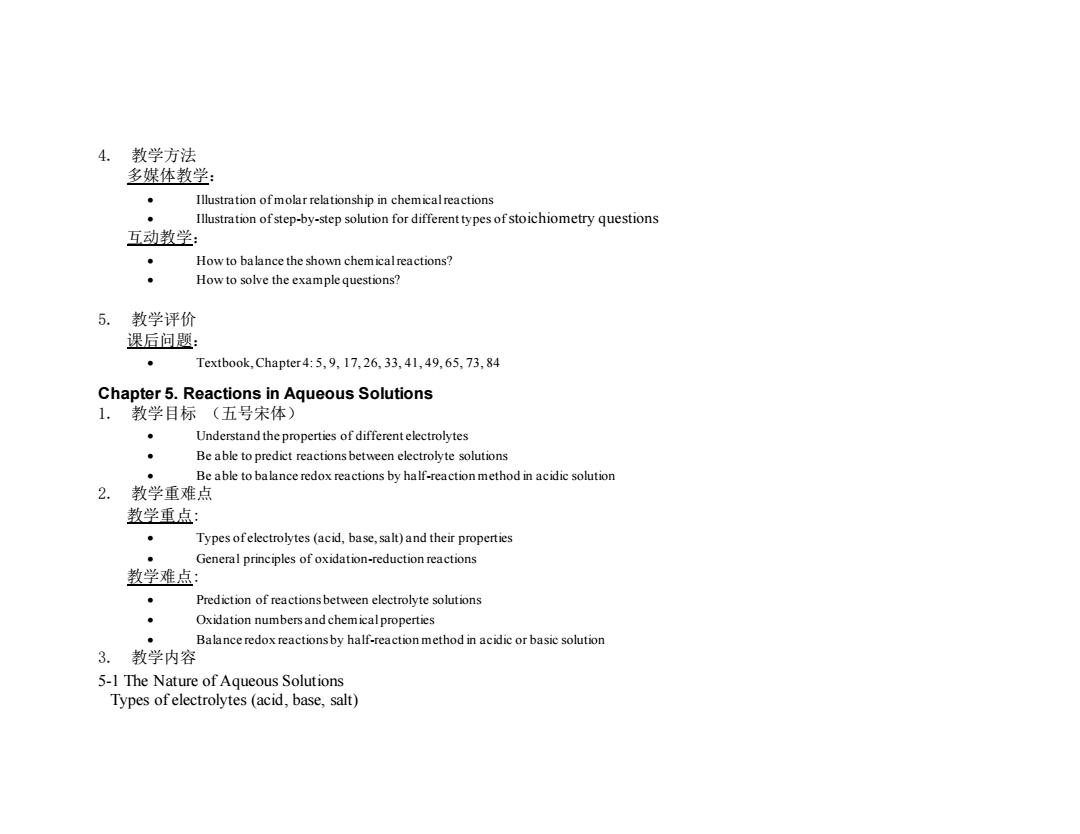
4. 教学方法 多媒体教学: Illustration ofmolar relationship in chemical reactions Illustration of step-by-step solution for different types of stoichiometry questions 互动教学: How to balance the shown chemical reactions? How to solve the example questions? 5. 教学评价 课后问题: Textbook,Chapter4:5,9,17,26,33,41,49,65,73,84 Chapter 5.Reactions in Aqueous Solutions 1.教学目标(五号宋体) Understand the properties of different electrolytes Be able to predict reactions between electrolyte solutions Be able to balance redox reactions by half-reaction method in acidic solution 2. 教学重难点 教学重点: Types ofelectrolytes(acid,base,salt)and their properties General principles of oxidation-reduction reactions 教学难点: Prediction of reactions between electrolyte solutions Oxidation numbers and chemical properties Balance redox reactionsby half-reaction method in acidic or basic solution 3.教学内容 5-1 The Nature of Aqueous Solutions Types ofelectrolytes (acid,base,salt)
4. 教学方法 多媒体教学: • Illustration of molar relationship in chemical reactions • Illustration of step-by-step solution for different types ofstoichiometry questions 互动教学: • How to balance the shown chemical reactions? • How to solve the example questions? 5. 教学评价 课后问题: • Textbook, Chapter 4: 5, 9, 17, 26, 33, 41, 49, 65, 73, 84 Chapter 5. Reactions in Aqueous Solutions 1. 教学目标 (五号宋体) • Understand the properties of different electrolytes • Be able to predict reactions between electrolyte solutions • Be able to balance redox reactions by half-reaction method in acidic solution 2. 教学重难点 教学重点: • Types of electrolytes (acid, base, salt) and their properties • General principles of oxidation-reduction reactions 教学难点: • Prediction of reactions between electrolyte solutions • Oxidation numbers and chemical properties • Balance redox reactions by half-reaction method in acidic or basic solution 3. 教学内容 5-1 The Nature of Aqueous Solutions Types of electrolytes (acid, base, salt)
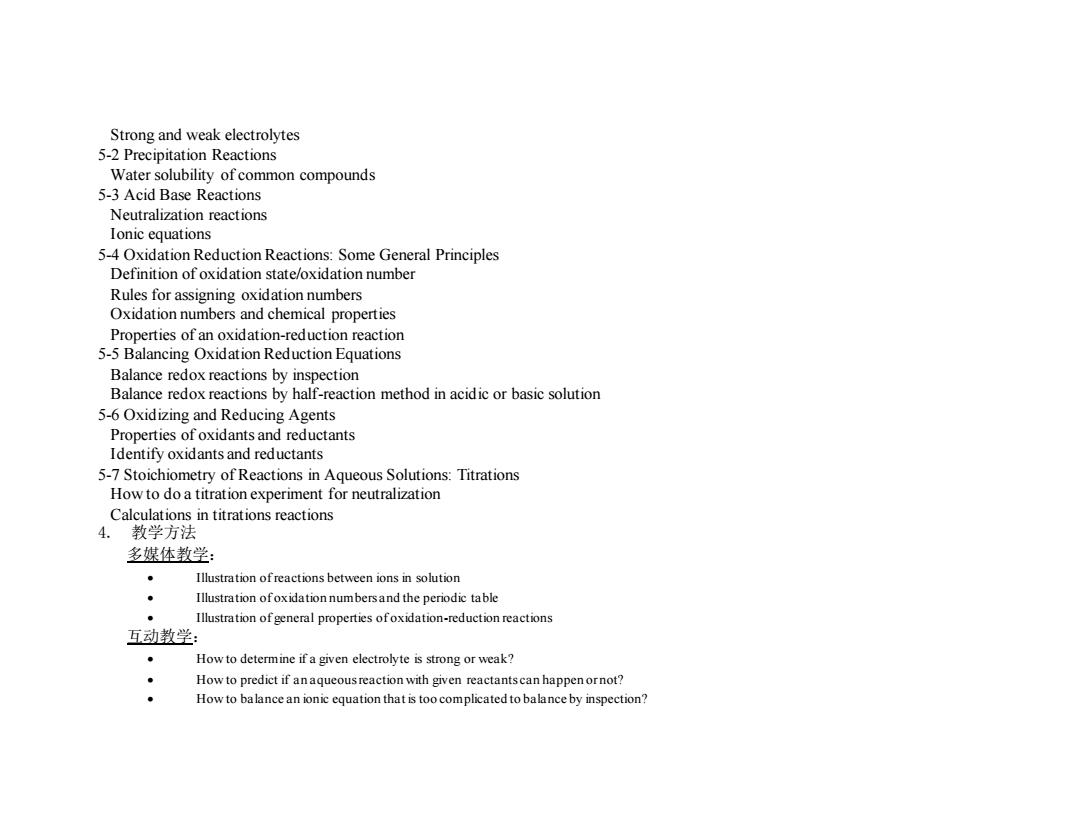
Strong and weak electrolytes 5-2 Precipitation Reactions Water solubility of common compounds 5-3 Acid Base Reactions Neutralization reactions Ionic equations 5-4 Oxidation Reduction Reactions:Some General Principles Definition of oxidation state/oxidation number Rules for assigning oxidation numbers Oxidation numbers and chemical properties Properties of an oxidation-reduction reaction 5-5 Balancing Oxidation Reduction Equations Balance redox reactions by inspection Balance redox reactions by half-reaction method in acidic or basic solution 5-6 Oxidizing and Reducing Agents Properties of oxidants and reductants Identify oxidants and reductants 5-7 Stoichiometry of Reactions in Aqueous Solutions:Titrations How to do a titration experiment for neutralization Calculations in titrations reactions 4.教学方法 多媒体教学: Illustration ofreactions between ions in solution Illustration ofoxidation numbersand the periodic table Illustration of general properties ofoxidation-reduction reactions 互动教学: How to determine if a given electrolyte is strong or weak? How to predict if anaqueous reaction with given reactants can happen ornot? How to balance an ionic equation that is too complicated to balance by inspection?
Strong and weak electrolytes 5-2 Precipitation Reactions Water solubility of common compounds 5-3 Acid Base Reactions Neutralization reactions Ionic equations 5-4 Oxidation Reduction Reactions: Some General Principles Definition of oxidation state/oxidation number Rules for assigning oxidation numbers Oxidation numbers and chemical properties Properties of an oxidation-reduction reaction 5-5 Balancing Oxidation Reduction Equations Balance redox reactions by inspection Balance redox reactions by half-reaction method in acidic or basic solution 5-6 Oxidizing and Reducing Agents Properties of oxidants and reductants Identify oxidants and reductants 5-7 Stoichiometry of Reactions in Aqueous Solutions: Titrations How to do a titration experiment for neutralization Calculations in titrations reactions 4. 教学方法 多媒体教学: • Illustration of reactions between ions in solution • Illustration of oxidation numbers and the periodic table • Illustration of general properties of oxidation-reduction reactions 互动教学: • How to determine if a given electrolyte is strong or weak? • How to predict if an aqueous reaction with given reactants can happen or not? • How to balance an ionic equation that is too complicated to balance by inspection?
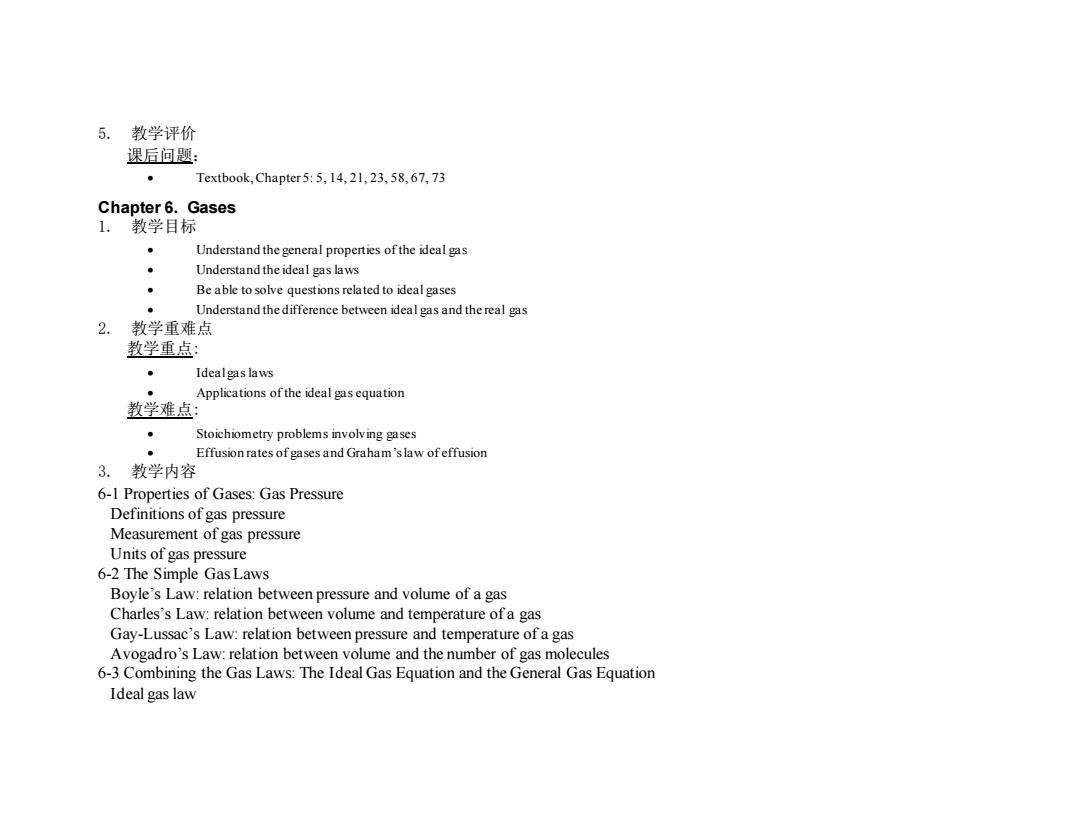
5.教学评价 课后问题: Textbook,Chapter 5:5,14,21,23,58,67,73 Chapter 6.Gases 1.教学目标 Understand the general properties of the ideal gas Understand the ideal gas laws Be able to solve questions related to ideal gases Understand the difference between ideal gas and the real gas 2. 教学重难点 教学重点: Idealgas laws Applications of the ideal gas equation 教学难点 Stoichiometry problems involving gases Effusion rates of gases and Graham's law of effusion 3.教学内容 6-1 Properties of Gases:Gas Pressure Definitions of gas pressure Measurement of gas pressure Units of gas pressure 6-2 The Simple Gas Laws Boyle's Law:relation between pressure and volume of a gas Charles's Law:relation between volume and temperature of a gas Gay-Lussac's Law:relation between pressure and temperature of a gas Avogadro's Law:relation between volume and the number of gas molecules 6-3 Combining the Gas Laws:The Ideal Gas Equation and the General Gas Equation Ideal gas law
5. 教学评价 课后问题: • Textbook, Chapter 5: 5, 14, 21, 23, 58, 67, 73 Chapter 6. Gases 1. 教学目标 • Understand the general properties of the ideal gas • Understand the ideal gas laws • Be able to solve questions related to ideal gases • Understand the difference between ideal gas and the real gas 2. 教学重难点 教学重点: • Ideal gas laws • Applications of the ideal gas equation 教学难点: • Stoichiometry problems involving gases • Effusion rates of gases and Graham’s law of effusion 3. 教学内容 6-1 Properties of Gases: Gas Pressure Definitions of gas pressure Measurement of gas pressure Units of gas pressure 6-2 The Simple Gas Laws Boyle’s Law: relation between pressure and volume of a gas Charles’s Law: relation between volume and temperature of a gas Gay-Lussac’s Law: relation between pressure and temperature of a gas Avogadro’s Law: relation between volume and the number of gas molecules 6-3 Combining the Gas Laws: The Ideal Gas Equation and the General Gas Equation Ideal gas law
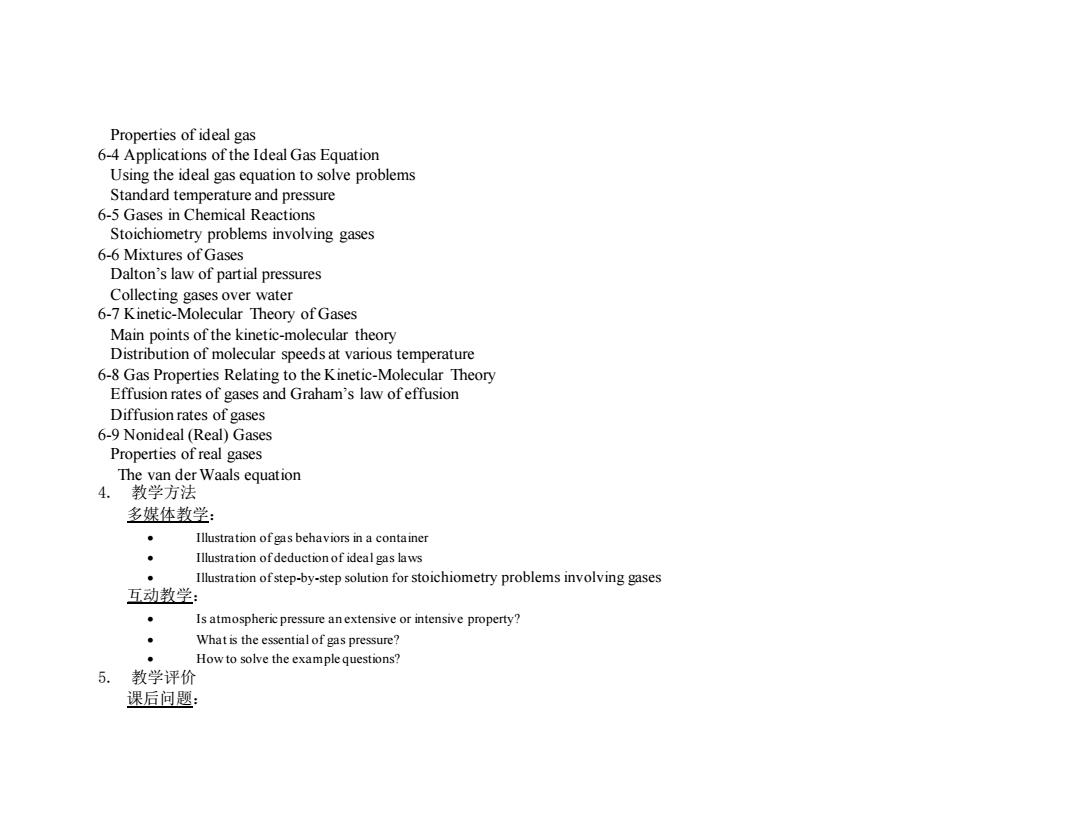
Properties of ideal gas 6-4 Applications of the Ideal Gas Equation Using the ideal gas equation to solve problems Standard temperature and pressure 6-5 Gases in Chemical Reactions Stoichiometry problems involving gases 6-6 Mixtures of Gases Dalton's law of partial pressures Collecting gases over water 6-7 Kinetic-Molecular Theory of Gases Main points of the kinetic-molecular theory Distribution of molecular speeds at various temperature 6-8 Gas Properties Relating to the Kinetic-Molecular Theory Effusion rates of gases and Graham's law of effusion Diffusion rates of gases 6-9 Nonideal (Real)Gases Properties of real gases The van der Waals equation 4.教学方法 多媒体教学: Illustration of gas behaviors in a container Illustration of deduction of ideal gas laws Illustration of step-by-step solution for stoichiometry problems involving gases 互动教学: Is atmospheric pressure an extensive or intensive property? What is the essential of gas pressure? How to solve the example questions? 5. 教学评价 课后问题:
Properties of ideal gas 6-4 Applications of the Ideal Gas Equation Using the ideal gas equation to solve problems Standard temperature and pressure 6-5 Gases in Chemical Reactions Stoichiometry problems involving gases 6-6 Mixtures of Gases Dalton’s law of partial pressures Collecting gases over water 6-7 Kinetic-Molecular Theory of Gases Main points of the kinetic-molecular theory Distribution of molecular speeds at various temperature 6-8 Gas Properties Relating to the Kinetic-Molecular Theory Effusion rates of gases and Graham’s law of effusion Diffusion rates of gases 6-9 Nonideal (Real) Gases Properties of real gases The van der Waals equation 4. 教学方法 多媒体教学: • Illustration of gas behaviors in a container • Illustration of deduction of ideal gas laws • Illustration of step-by-step solution forstoichiometry problems involving gases 互动教学: • Is atmospheric pressure an extensive or intensive property? • What is the essential of gas pressure? • How to solve the example questions? 5. 教学评价 课后问题:
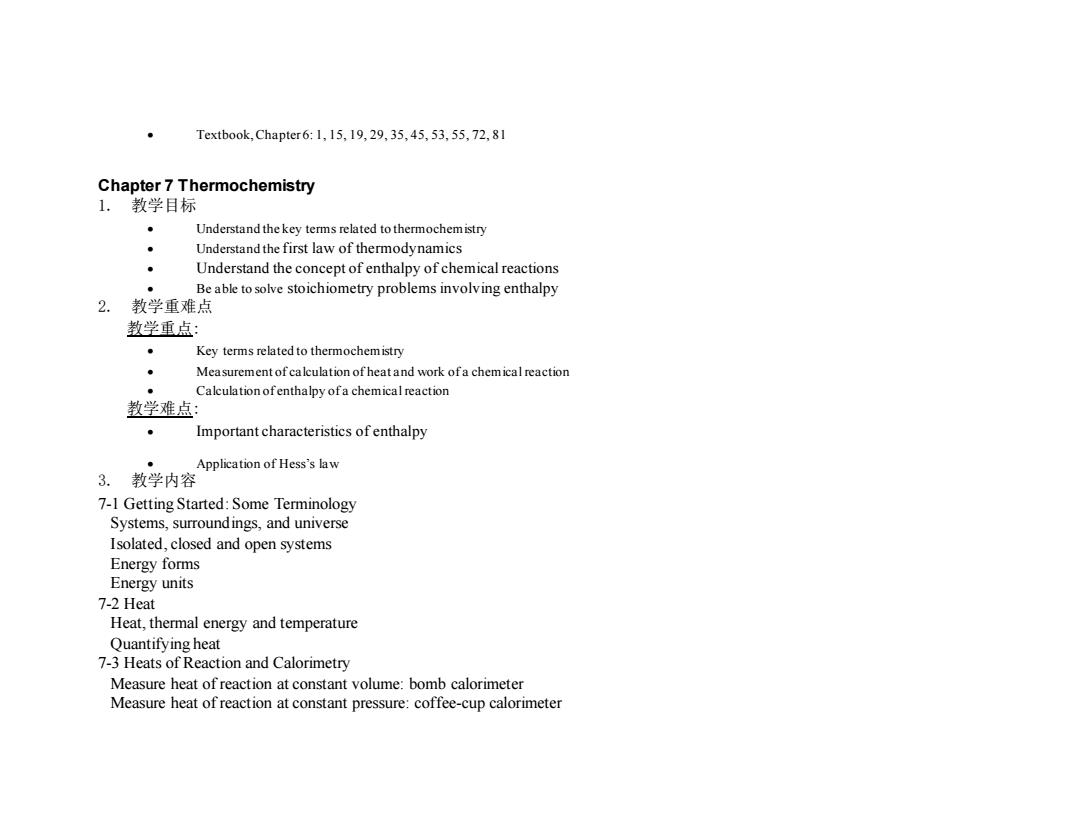
● Textbook,Chapter6:1,15,19,29,35,45,53,55,72,81 Chapter 7 Thermochemistry 1.教学目标 Understand the key terms related to thermochemistry Understand the first law of thermodynamics Understand the concept of enthalpy of chemical reactions Be able to solve stoichiometry problems involving enthalpy 2. 教学重难点 教学重点: Key terms related to thermochemistry Measurement of calculation of heat and work ofa chemical reaction Calculation ofenthalpy ofa chemical reaction 教学难点 Important characteristics of enthalpy Application of Hess's law 3.教学内容 7-1 Getting Started:Some Terminology Systems,surround ings,and universe Isolated,closed and open systems Energy forms Energy units 7-2 Heat Heat,thermal energy and temperature Quantifying heat 7-3 Heats of Reaction and Calorimetry Measure heat of reaction at constant volume:bomb calorimeter Measure heat ofreaction at constant pressure:coffee-cup calorimeter
• Textbook, Chapter 6: 1, 15, 19, 29, 35, 45, 53, 55, 72, 81 Chapter 7 Thermochemistry 1. 教学目标 • Understand the key terms related to thermochemistry • Understand the first law of thermodynamics • Understand the concept of enthalpy of chemical reactions • Be able to solve stoichiometry problems involving enthalpy 2. 教学重难点 教学重点: • Key terms related to thermochemistry • Measurement of calculation of heat and work of a chemical reaction • Calculation of enthalpy of a chemical reaction 教学难点: • Important characteristics of enthalpy • Application of Hess’s law 3. 教学内容 7-1 Getting Started: Some Terminology Systems, surroundings, and universe Isolated, closed and open systems Energy forms Energy units 7-2 Heat Heat, thermal energy and temperature Quantifying heat 7-3 Heats of Reaction and Calorimetry Measure heat of reaction at constant volume: bomb calorimeter Measure heat of reaction at constant pressure: coffee-cup calorimeter